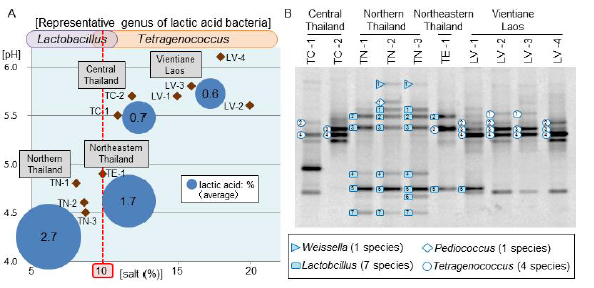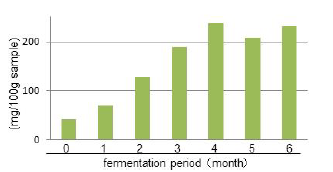Importance of salt concentration and long-term fermentation in the quality of salty-fermented freshwater fish paste in Thailand and Laos
Description
The salty-fermented freshwater fish paste known as pla-ra and pa-daek in Thailand and Laos is universally used in daily meals as a storage-stable almighty seasoning or protein-rich cooking ingredient. It is traditionally made at home and also sold on the market nowadays. For the preparation, raw fish is mixed with salt and rice bran or roasted rice powder, and then fermented at tropical temperatures for at least 6 months. It is generally believed that longer fermentation makes the products taste better. Moreover, consumers often think the taste of the products varies from place to place. Scientific evidences regarding such characteristic features and microbes involved in the fermentation are expected to be useful in promoting quality improvement and consumption of pla-ra / pa-daek products, which are traditional high-value-added products that highly utilize indigenous fishery resources particularly in the inland region of Southeast Asia.
Regional characteristics of the pH and salt concentration are observed in the samples examined (Fig. 2A). The product pH is positively correlated with the salt concentration (Fig. 2A). Multiple species (2-8 species) of lactic acid bacteria are detected by the culture-independent method (summarized in Fig. 1) in 10 pla-ra / pa-daek products collected from central, northern, and northeastern Thailand, and Vientiane in Laos (Fig. 2B). The products can be classified into two groups by the representative genus of lactic acid bacteria, such as Tetragenococcus or Lactobacillus. Salt concentration of approximately 10% is the dividing point between these two groups (Fig. 2A). Products in the latter group contain relatively higher amount of lactic acid. The amount of glutamic acid, which is the source of delicious taste, increases in a fermentation-time dependent manner by 4 to 6 months in products prepared by following a common recipe (Fig. 3). Glutamic acid is one of the amino acids generated by the digestion of fish protein during fermentation.
Taken together, salt concentration is a key factor in determining the activity of lactic acid bacteria and the resulting lactic acid amount that relates to the regionality in taste preference. The producers can utilize a simple tool, such as a test paper, to monitor the salt concentration and pH for improving product quality and productivity. The overgrowth of Lactobacillus species that possibly results in acidification of the product by excess acid production can be prevented by controlling the salt concentration accordingly. It is recommended that the fermentation be continued long enough to generate a sufficient amount of glutamic acid.
Figure, table
-
Fig. 1. Scheme of the taste component measurement and genetic identification of bacteria by culture independent method (PCR-DGGE)
-
Fig. 2. A: Correlation and regionality of the taste components; B: Characteristics of lactic acid bacteria species detected by the PCR-DGGE method
-
Fig. 3. Time-dependent change of the glutamic acid (source of delicious taste) during fermentation of pla-ra prepared by following a common recipe
- Affiliation
-
Japan International Research Center for Agricultural Sciences Biological Resources and Post-harvest Division
- Classification
-
Administration B
- Research project
- Program name
- Term of research
-
FY 2014 (FY 2011-FY 2015)
- Responsible researcher
-
Marui Junichiro ( Biological Resources and Post-harvest Division )
MIERUKA ID: 001765Boulom Sayvisene ( National University of Laos )
Panthavee Wanchai ( Kasetsart University )
Trakoontivakorn Gassinee ( Kasetsart University )
Tangkanakul Plernchai ( Kasetsart University )
Kusumoto Ken-ichi ( National Food Research Institute )
KAKEN Researcher No.: 80353978 - ほか
- Publication, etc.
-
https://doi.org/10.12938/bmfh.2014-018
Marui et al. Bioscience of Microbiota Food and Health, Vol. 34 (2015) No. 2 p. 45-52
- Japanese PDF
-
2014_C04_A3_ja.pdf486.85 KB
2014_C04_A4_ja.pdf598.87 KB
- English PDF
-
2014_C04_A3_en.pdf374.3 KB
2014_C04_A4_en.pdf193.43 KB
- Poster PDF
-
2014_C04_poster.pdf359.43 KB



